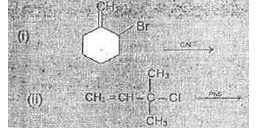Write a note on nucleophiles. Solution in Gujrati
Nucleophiles are negatively charged or neutral species that is capable of donating electrons. These species are electron deficient centres attracting molecules.
Nucleophiles not only donate an electron pair to an electron deficient centre but also forms bond with that atom. Whereas bases donate an electron pair to H+.

Examples of Nucleophile are :
(i) Charged nucleophiles : −CN,I−,Br−,Cl−,OH−,−SH,−OR,−CH3,−NH2,−H,−C≡CH etc.
(ii) Neutral nucleophiles : H2..O:,H2..S:,CH3..O..H,(CH3)2..O: etc.
Nucleophilicity is defined as the ability of a nucleophile to react with an electron deficient centre. Nucleophilicity is kinetically controlled whereas basicity is thermodynamically controlled.
Certain anionic nucleophiles have negative charge delocalised by resonance over two different atoms or to non - equivalent atoms. These nucleophiles are known as ambident nucleophiles. Ex : −CN,NO−2, etc. The cyanide group is a hybrid of two contributing structures and therefore can act as a nucleophile in two different ways :
өC≡N↔:C=Nө
The linking of cynide group through carbon atom results in alkyl cyanides and through nitrogen atom results in isocyanides. Similarly nitrite ion also represents an ambident nucleophilicity with two different atoms of linkage [өO−..N=..O:]
The linkage through oxygen results in alkyl nitrites while through nitrogen atom, it leads to nitroalkanes.
The nucleophilicity of a nucleophile is affected by :
(i) Size of a nucleophile
(ii) Electronegativity of electron donor atom
(iii) Electron density on electron donor atrom
(iv) Presence of solvents.
Topper's Solved these Questions
- BOOK - KUMAR PRAKASHANCHAPTER - HALOALKANES AND HALOARENESEXERCISE - SECTION - B INTEXT QUESTIONS AND ANSWERS20videos
HALOALKANES AND HALOARENES
- BOOK - KUMAR PRAKASHANCHAPTER - HALOALKANES AND HALOARENESEXERCISE - SECTION - C TEXTUAL EXERCISE87videos
HALOALKANES AND HALOARENES
- BOOK - KUMAR PRAKASHANCHAPTER - HALOALKANES AND HALOARENESEXERCISE - SECTION - E Multiple Choice Questions260videos
HALOALKANES AND HALOARENES
- BOOK - KUMAR PRAKASHANCHAPTER - GENERAL PRINCIPLES AND PROCESSES OF ISOLATION OF ELEMENTSEXERCISE - SECTION - E (MCQs ASKED IN GUJET/BOARD EXAMS)46videos
GENERAL PRINCIPLES AND PROCESSES OF ISOLATION OF ELEMENTS
- BOOK - KUMAR PRAKASHANCHAPTER - POLYMERSEXERCISE - SECTION - E (MCQs asked in Board Exams)51videos
POLYMERS
Similar Questions
Write the structures of the following compounds :
2-Chloro-3-methylentane03:31View SolutionName the following halides according to IUPAC system and classify them as alkyl, allyl, benzyl (primary, secondary, tertiary), vinyl or aryl halides :
(CH3)2CHCH(Cl)CH3View SolutionThe derivatives that are not found in nature are …..
05:47View SolutionDuring electrolysis of aqueous solution of Na2SO4 using graphite electrode .........
04:59View SolutionWhich polymer is used in preparation of capsules ?
02:47View SolutionWrite a note on genetic control of ABO Blood groups. " " (OR) Write a note on Thalassemia.
03:40View SolutionWrite the structure of the nucleophilic substitution products in each of the following
 01:41View Solution
01:41View SolutionWrite down nucleophilic substitution (S_N2) order for following.
03:59View Solution(a) Give mechanism for the nucleophilic addition reaction of HCN with propanone. (b ) Write a note on aldol condensation.
03:16View SolutionWrite the mechanism of nucleophilic addition reactions of carbonyl compound .
05:30View SolutionWrite down nucleophilic substitution (S_N2) order for following.
08:35View SolutionWrite the mechanism of nucleophilic addition reactions of carbonyl compounds.
02:15View SolutionWhat are ambident nucleophiles ? Explain write an examples too.
07:34View SolutionWrite a note on:
02:27View SolutionWrite a note on:
04:08View Solution

